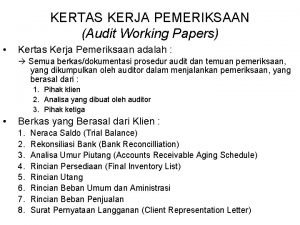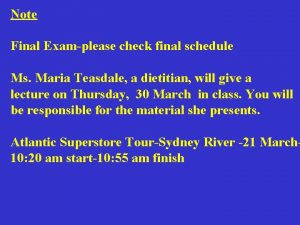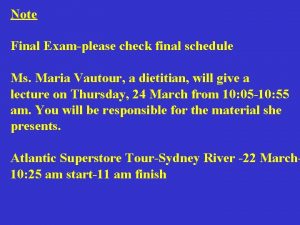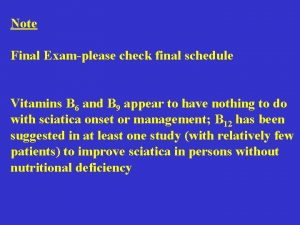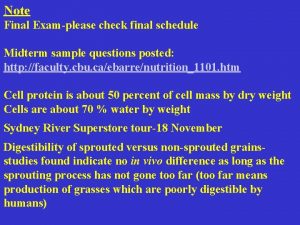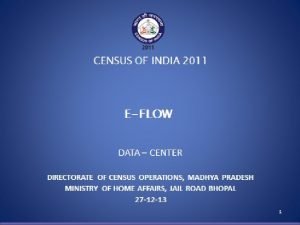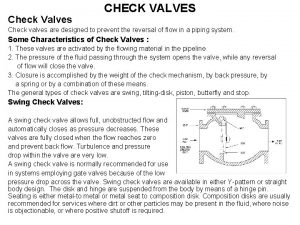Note Final Examplease check final schedule Lecture 24























- Slides: 23

Note Final Exam-please check final schedule

Lecture 24 - 4 March 2011 Proteins

Proteins Comes from the Greek word protos meaning of prime importance

What are they? -chains of amino acids -an amino acid is an organic acid with a side group and an NH 2 group attached

Functions of proteins in the body -structure -hair, nails, cells -mechanical functions motor proteins -eg contractile proteins in muscle

Functions of proteins in the body -enzymes -aid in reactions- make the reactions go faster -hormones -signals to cells -eg insulin -antibodies -help fight infection

Functions of proteins in the body -fluid balance -osmotic influence -acid base balance -charge on certain proteins affects p. H -channels e. g. -move ions into and out of cells

Functions of proteins in the body -pumps -move substances across cell wall by use of energy -transport -eg -lipoproteins transport fat in bloodstream -carry fat soluble vitamins -source of energy and glucose -when protein is broken down it gives energy

Functions of proteins in the body -used to make neurotransmitters

Digestion of protein -stomach –acid -denatures-straightens out proteins –readies them for small intestine digestion of proteins -small intestine- enzymes attack proteins and make them into amino acids

Absorption of protein Amino acids moved across intestinal wall into blood Transport of protein No special needed-the amino acids are water soluble

Excretion Proteins are broken down into amino acids and then amino acids are further broken down- urea is one product of amino acid breakdown, urea and other components of protein breakdown are put in the urine and excreted

How are proteins made in the body? -remember protein in is not protein out -proteins are made from copies of DNA

Nitrogen balance -positive nitrogen balance- more protein being made than broken down –pregnant female -zero nitrogen balance- protein is being made as fast as it is being broken down-healthy person -negative nitrogen balance- protein is being broken down faster than it is being made eg illness

Recommended intake of protein Infants 0 -6 months 2. 2 g/kg body weight/day Children 1 -1. 6 g/kg body weight/day Adults 0. 8 g/kg body weight/day Seniors 0. 8 g/kg body weight/day -For all about 15 -20 % of daily energy intake -Must be high quality (complete) protein

Protein quality Complete proteins –correct balance of essential amino acids Definitions of two types of amino acids -essential and non-essential Most animal proteins are complete Many plant proteins are incomplete- exception soybean protein

Complementarity Beans and rice Beans and corn Rice and lentils Pasta and beans Peanut butter on bread

Estimating protein intake Food labels will allow you to do this Following Canada’s food guide will allow you to estimate this

Vegetarianism Types of diets


Health risks Vegans-low in iron, calcium, zinc, vitamin D and B 6 and B 12 -higher intakes of oxalates Fruitarian-limited in many essential nutrients Supplements of deficient nutrients frequently required for vegans and fruitarians

Protein deficiencies Protein energy malnutrition (PEM) Marasmus Wasting- skin and bones look Not enough energy or protein Kwashiokor Evil spirit that affects first child when the second one is born Enough energy not enough protein Swollen belly appearance

Excess protein intake Risk of cancer, heart disease and osteoporosis and renal failure
 01:640:244 lecture notes - lecture 15: plat, idah, farad
01:640:244 lecture notes - lecture 15: plat, idah, farad Lecture note tiu
Lecture note tiu Difference between note making and note taking
Difference between note making and note taking Note making advantages
Note making advantages Financial documents in order
Financial documents in order A simple discount note results in
A simple discount note results in Difference between note making and note taking
Difference between note making and note taking Debit note format
Debit note format Singnal words
Singnal words How to write debit note
How to write debit note Bmfp
Bmfp Non interest bearing note amortization schedule
Non interest bearing note amortization schedule Pemilikan dan penyimpanan kertas kerja pemeriksaan
Pemilikan dan penyimpanan kertas kerja pemeriksaan Fomema check
Fomema check Part 5 preparing a check stub and check
Part 5 preparing a check stub and check Check in check out
Check in check out Check in check out behavior intervention
Check in check out behavior intervention Check my progress vocabulary check
Check my progress vocabulary check Check in check out system for students
Check in check out system for students Check in check out intervention
Check in check out intervention Jobbank
Jobbank 1.7.6 - quick check: frost quick check
1.7.6 - quick check: frost quick check Check in check out forms
Check in check out forms Behavior check in check out sheet
Behavior check in check out sheet












